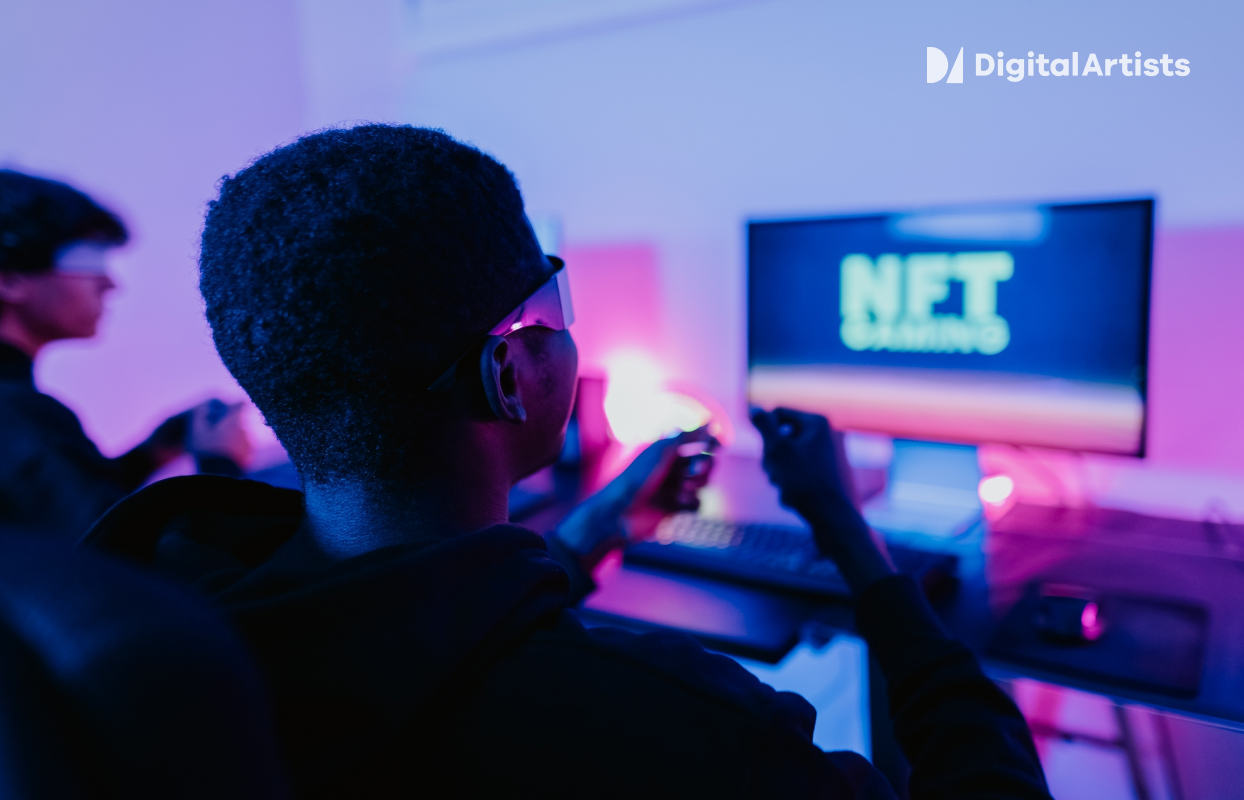


The world of entertainment has always thrived on innovation, and the emergence of Non-Fungible Tokens (NFTs) is a testament to this evolution. As unique digital assets verified through blockchain technology, NFTs have redefined the value proposition in the entertainment industry. From music to film, art to video games, creators are now able to tokenize their work, granting them new avenues for monetization and enhanced ownership rights in the realm of NFT entertainment.
Fans, on the other hand, find allure in the exclusivity and provenance that comes with holding an authentic piece of digital memorabilia in the NFT entertainment world. The introduction of NFTs challenges traditional models of copyright and distribution, introducing a paradigm where digital assets, once easily duplicated and shared, can now possess singular value. As the entertainment business adapts to this new frontier, discussions surrounding the opportunities and implications of NFTs have become central to its future landscape.
NFTs, or Non-Fungible Tokens, have emerged as a revolutionary concept in the world of digital assets and ownership. Simply put, NFTs are unique, indivisible tokens that represent ownership or proof of authenticity of a specific digital or physical item. They are distinct from cryptocurrencies like Bitcoin or Ethereum, which are fungible and can be exchanged on a one-to-one basis.
The core technology behind NFT entertainment is blockchain, a decentralized and tamper-resistant digital ledger. Each NFT is stored on a blockchain, typically Ethereum, but there are other blockchains used for this purpose as well. The blockchain records information about the NFT, including its ownership and transaction history, ensuring its provenance and uniqueness.
NFTs can represent a wide range of digital or physical assets, including:
Digital Artwork: NFTs have become synonymous with digital art, allowing artists to create, tokenize, and sell their work in digital form. Each NFT certifies the authenticity and ownership of the digital art piece.
Collectibles: NFTs are used to create digital collectibles like trading cards, virtual pets, and rare in-game items. These tokens allow collectors to buy, sell, and trade these digital assets.
Music and Videos: Musicians, filmmakers, and content creators can release music albums, videos, or exclusive content as NFTs, granting buyers unique access or ownership.
Virtual Real Estate: In virtual worlds and games, NFTs represent virtual real estate, allowing users to buy, sell, and develop digital land parcels.
Tickets and Tokens: NFTs can also represent tickets to events, exclusive memberships, or access keys to online communities.
NFTs work on the principle of scarcity and uniqueness. Their value is derived from their scarcity, authenticity, and the demand for the underlying asset. When someone purchases an NFT, they gain ownership and control over that specific digital or physical item as recorded on the blockchain. The owner can choose to keep, sell, or trade the NFT as they see fit, and these transactions are transparent and immutable, thanks to blockchain technology. This combination of uniqueness, digital ownership, and transparency has opened up new possibilities across various industries, from art and entertainment to gaming and beyond.
The world of entertainment has always thrived on innovation, and the emergence of Non-Fungible Tokens (NFTs) is a testament to this evolution. As unique digital assets verified through blockchain technology, NFTs have redefined the value proposition in the entertainment industry.
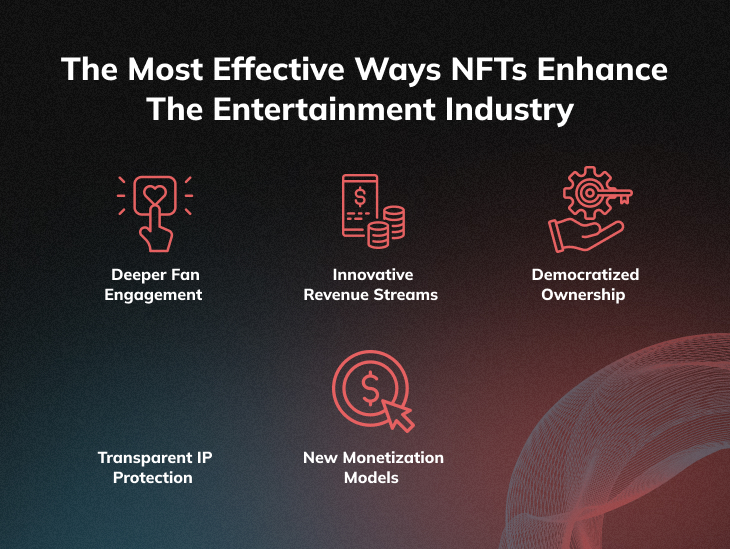
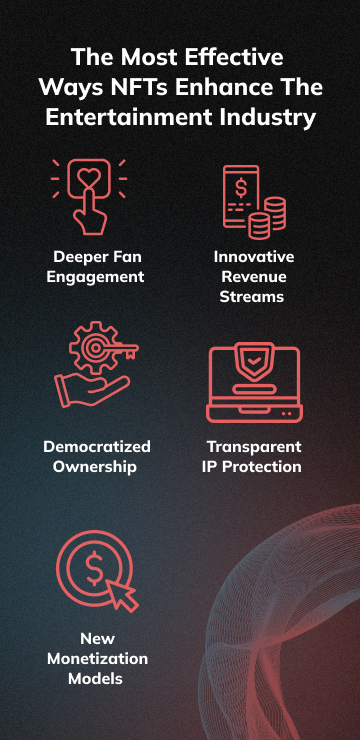
From music to film, art to video games, creators in the NFT entertainment realm are now able to tokenize their work, granting them new avenues for monetization and enhanced ownership rights. Fans, on the other hand, find allure in the exclusivity and provenance that comes with holding an authentic piece of digital memorabilia. The introduction of NFTs challenges traditional models of copyright and distribution, introducing a paradigm where digital assets, once easily duplicated and shared, can now possess singular value. As the entertainment business adapts to this new frontier, discussions surrounding the opportunities and implications of NFTs have become central to its future landscape.
NFTs provide the entertainment industry with a powerful tool to engage their audiences on a deeper level. By offering exclusive content drops as NFTs, businesses foster a sense of community and exclusivity. Fans become stakeholders with a direct connection to their favourite entertainment, driving engagement and loyalty.
NFTs introduce novel revenue streams for content creators in the entertainment sector. Companies and artists can tokenize their work, selling it as limited-edition digital collectibles, including movie NFTs. These tokens can be bought and sold on blockchain marketplaces, generating income streams beyond traditional sales or licensing agreements.
NFTs democratize content ownership in the entertainment business. Fans can own a piece of entertainment history by purchasing tokens representing iconic moments, articles, digital art, or collectibles, including NFT movies. This empowers audiences, allowing them to hold tangible stakes in the content they love, enhancing their emotional connection.
Blockchain’s transparency and immutability make it a powerful tool for protecting intellectual property (IP) in the entertainment sector. Companies can use NFTs to timestamp and authenticate content, proving its origin and ownership within the entertainment NFT space. This helps combat piracy and ensures fair compensation for creators.
Non-Fungible-Tokens open up innovative monetization models for the NFT in entertainment industry. Companies can sell virtual merchandise, tickets to virtual events, or even memberships as NFTs. This expands the scope of possibilities, making it easier to monetize fan engagement and offer unique, value-added experiences.
For consumers, NFTs offer a genuine sense of ownership. Digital collectibles, be they clips from a legendary concert or a piece of virtual art, can be owned, showcased, and even resold, making the fan’s connection to their favourite entertainment more profound.
Furthermore, NFTs have opened a new realm for innovative marketing strategies. Limited edition digital assets can create buzz, drive fan engagement, and foster a deeper bond between artists and their audience.
In essence, NFTs are redefining value, ownership, and the relationship dynamics in the entertainment sector, ushering in an era of enhanced creativity and consumer empowerment.
NFTs, or Non-Fungible Tokens, have invigorated the entertainment business, offering a novel way to monetize digital assets. By providing verifiable authenticity and ownership via blockchain, NFTs empower artists to sell limited edition music, artwork, or film snippets directly to fans. This model bypasses traditional intermediaries, leading to higher revenue for creators. For fans, owning a unique digital collectible intensifies their connection to their favourite stars or franchises in the NFT entertainment industry.
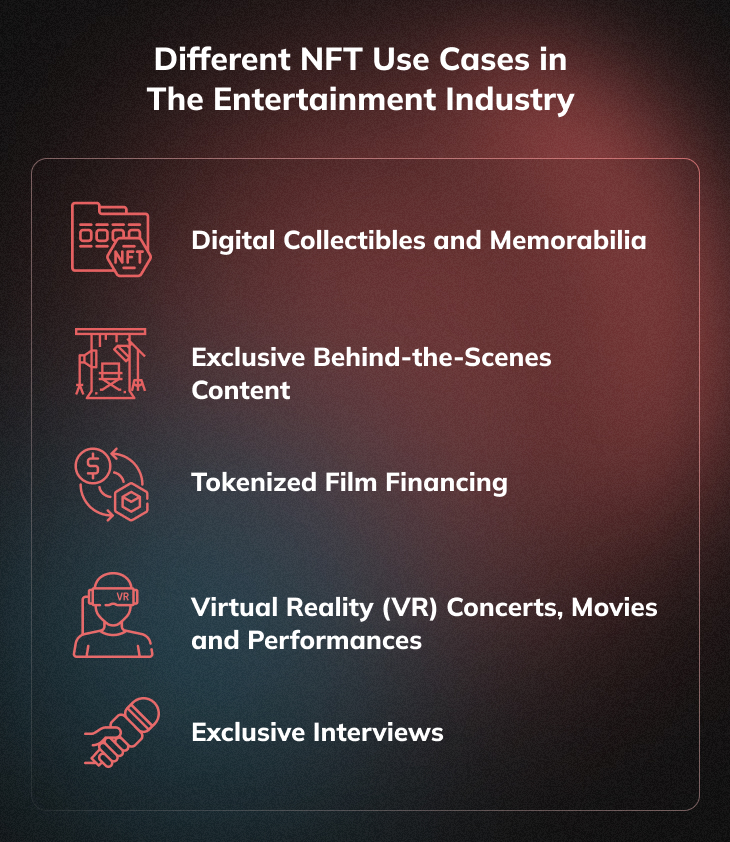
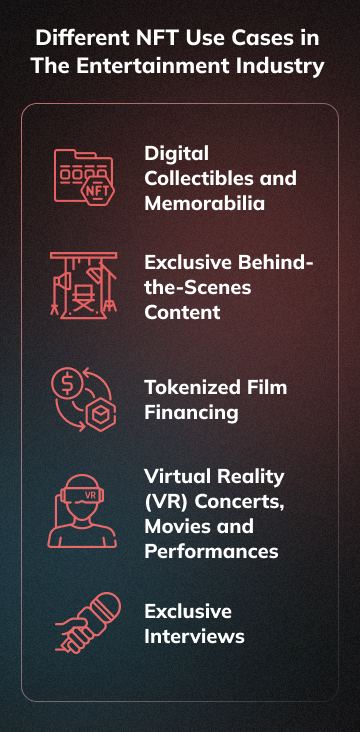
As a pioneering blend of tech and art, NFTs herald a paradigm shift, redefining the value, distribution, and ownership dynamics in today’s entertainment landscape.
The evolution of media and entertainment has taken an intriguing turn with the rise of digital collectibles and memorabilia. These are unique digital assets, often tokenized using blockchain technology as Non-Fungible Tokens (NFTs). Unlike regular digital files that can be copied endlessly with no loss of quality, NFTs provide proof of authenticity and ownership, ensuring that each digital collectible is one-of-a-kind.
For instance, an artist might release a limited number of digital posters or a filmmaker might tokenize a specific movie scene, allowing fans to purchase and own them. Once acquired, these digital items can be showcased in virtual galleries, traded on various online platforms, or held as a form of investment. The underlying blockchain technology ensures that the provenance and rarity of each item are preserved. In essence, these digital assets merge the fervor of traditional memorabilia collecting with the vast possibilities of the digital realm, forging a new frontier in the media and entertainment business.
Behind-the-scenes content has always tantalized avid fans, offering a peek into the magical world of creation. In the modern media and entertainment landscape, this allure has been amplified through the strategic use of exclusive content.
Creators often capture raw moments—rehearsals, bloopers, production challenges, or intimate artist interviews—and release them as premium offerings. These unique glimpses not only foster a deeper connection between fans and creators but also present monetization avenues. Platforms may offer subscriptions or pay-per-view models for this content, adding a fresh revenue stream.
With the advent of blockchain and NFTs, there’s even potential to tokenize behind-the-scenes moments, turning them into collectible digital assets. Fans could own a specific candid shot, an unreleased clip, or an exclusive director’s narration. This model merges fan engagement with potential investment, making exclusive behind-the-scenes content a potent tool in the evolving entertainment industry.
In an industry where raising capital for projects often proves challenging, tokenized film financing emerges as a transformative solution. This innovative model employs blockchain technology, particularly Non-Fungible Tokens (NFTs), to generate funds for film and media projects.
Here’s how it works: Filmmakers or production houses mint unique tokens representing a stake or a specific asset related to their project. This could range from early access to the finished product, exclusive merchandise, a mention in the credits, or even a fractional ownership of the film’s future revenue. These tokens are then sold to investors and fans, raising capital necessary for production.
What sets tokenized financing apart is the democratization of the investment process. No longer restricted to large investors or production studios, anyone can have a stake in a film’s success. For filmmakers, it provides a broader base of potential funders, and for fans, it’s an opportunity to be a tangible part of projects they believe in.
Additionally, with each token’s provenance and ownership securely logged on the blockchain, investors have verifiable proof of their stake, ensuring transparency and trust in this nascent funding avenue. As the media and entertainment industry evolves, tokenized film financing stands out, marrying technology, fan engagement, and investment in an unprecedented way.
Virtual Reality (VR) has redefined the boundaries of the media and entertainment industry, offering audiences immersive experiences that were once the stuff of science fiction. By donning a VR headset, one can be virtually transported to concert arenas, movie settings, or theatrical stages, feeling as if they’re physically present in that space.
In the case of VR concerts, artists perform either live or in pre-recorded sessions, and fans from around the globe can “attend” these concerts virtually. They experience the music, light shows, and even the sensation of being amidst a crowd, all from the comfort of their homes.
VR movies, on the other hand, are not just about passive viewing. They allow audiences to step into the narrative, exploring the cinematic world in 360 degrees. Viewers can often choose where to look, making each viewing experience unique.
Performances, like theatre or dance, benefit immensely from VR. Artists can craft intricate performances where the viewer can be at the centre of the action or shift perspectives, offering a dynamic engagement unlike traditional stage shows.
To facilitate these, production houses create high-definition 3D recordings using special cameras and then render them for VR platforms. As technology advances, the line between virtual and reality continues to blur, offering unprecedented entertainment experiences.
Exclusive interviews have long been a cornerstone of the media and entertainment industry, offering audiences an intimate look into the lives and minds of their favourite celebrities, creators, and influencers. These one-on-one conversations, often conducted by seasoned journalists or talk show hosts, delve into topics ranging from an artist’s creative process and personal stories to upcoming projects and perspectives on pertinent issues.
The exclusivity of such interviews makes them highly coveted. They are typically arranged between the artist’s management and media outlets, with both parties seeing mutual benefits. For the media platform, be it a magazine, television show, or digital portal, exclusive interviews draw significant viewer or reader interest, leading to increased sales or viewership. On the other hand, for celebrities and creators, these interviews offer a controlled environment to share narratives, promote new work, or clarify controversies.
With the rise of digital media, the format of exclusive interviews has evolved. Beyond traditional print and TV, we now see live-streamed conversations, podcast episodes, or interactive Q&A sessions on social media platforms. However, regardless of the medium, the core remains unchanged: offering fans a closer, unfiltered connection to the personalities they admire.
The landscape of the entertainment industry is undergoing a dynamic shift, with many pioneering companies harnessing the potential of Non-Fungible Tokens (NFTs). These digital assets, unique and verifiable via blockchain technology, are being integrated into various entertainment facets, from music and film to art and memorabilia.
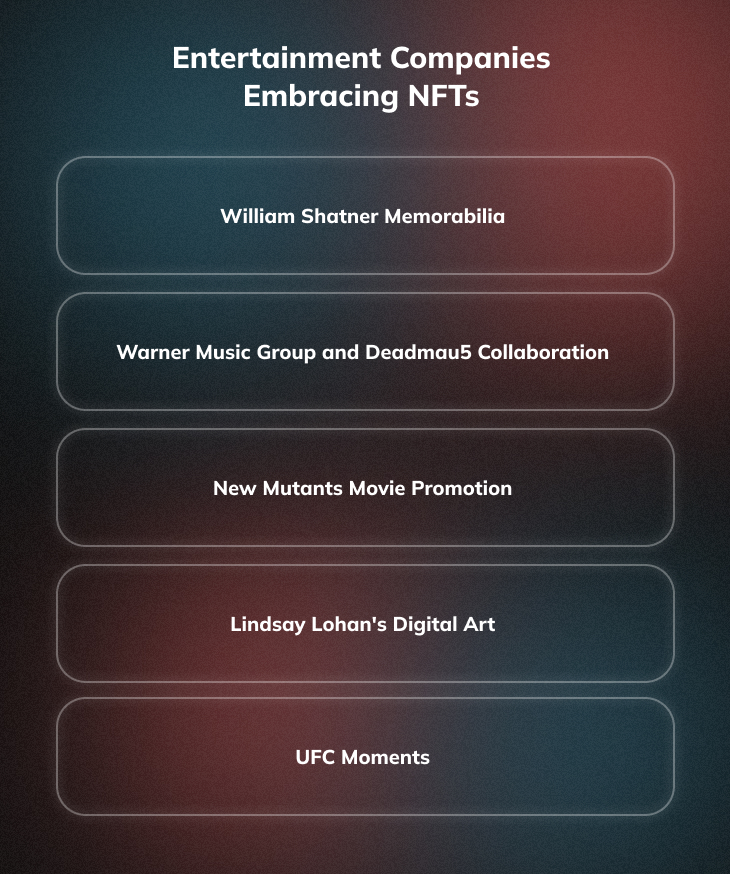
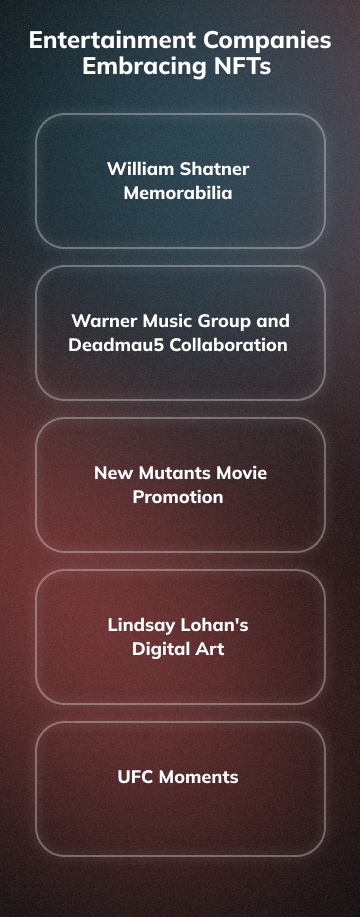
Leading entertainment companies see NFTs as a novel way to monetize content, engage with fans on a deeper level, and offer unparalleled exclusivity within the NFT entertainment industry. From releasing limited-edition music albums to tokenized film scenes, these trailblazing companies are redefining the boundaries of fan engagement, ownership, and value proposition in today’s dynamic entertainment landscape.
William Shatner, the legendary actor best known for his portrayal of Captain James T. Kirk in “Star Trek,” embarked on a pioneering journey into the digital realm with his own line of NFT-based memorabilia. Utilizing the WAX blockchain, Shatner released digital trading cards featuring intimate moments from his personal life and illustrious career, turning cherished memories into tradable assets.
Here’s how it works: The digital trading cards are tokenized as Non-Fungible Tokens (NFTs), ensuring each piece is unique and cannot be replicated. Fans and collectors can purchase, trade, or hold these tokens, enjoying the guarantee of blockchain technology that their digital possession is authentic and traceable back to its origin.
Among the array of offerings, Shatner’s NFT collection featured rare photographs from his early theatre days, snapshots taken on the “Star Trek” set, and personal mementos that have never been shared publicly before. One notable example includes a digital scan of a real X-ray of Shatner’s teeth!
This endeavor not only underscored Shatner’s forward-thinking approach to fan engagement but also highlighted the vast potential of NFTs to redefine celebrity memorabilia, bringing a traditional form of fandom into the digital age.
Warner Music Group, a titan in the music industry, and Deadmau5, the renowned electronic music producer, orchestrated a groundbreaking collaboration in the realm of NFTs, signaling a new direction in how music meets technology. This partnership encapsulates the blend of music, digital art, and collectibles into singular experiences, all tokenized on the blockchain.
The mechanism is fascinating. Deadmau5’s music, often accompanied by unique visual components or interactive experiences, gets tokenized as NFTs. These are then sold, giving fans not just a listening experience, but a unique digital asset they can own, trade, or even display in virtual spaces.
One notable example of this collaboration is the release of limited edition NFT packs containing rare and exclusive music and digital collectibles. These packs might contain unreleased tracks, immersive visual artworks, or interactive experiences exclusive to the NFT holder. Each NFT’s uniqueness is ensured by blockchain, giving every piece its distinct value and verifiability.
The Warner Music Group and Deadmau5 partnership exemplifies the next frontier in music consumption. It’s not just about listening anymore. It’s about experiencing, owning, and interacting with music in ways previously unimagined.
20th Century Studios, in promoting their film “New Mutants,” ventured into the burgeoning domain of NFTs, offering fans a novel, digital spin on movie memorabilia. This approach aimed to marry the age-old excitement of film promotions with the innovative flair of blockchain technology.
Here’s the essence of the campaign: To generate buzz and provide exclusive collectibles to fans, the studio released a limited series of digital posters for “New Mutants” as NFTs. Each of these posters was tokenized, ensuring its distinctiveness and authenticity, and then made available for fans to acquire.
A particularly captivating example includes a dynamic digital poster featuring the character Magik, played by Anya Taylor-Joy. As an NFT, this poster wasn’t just a static image – it was a dynamic digital artwork, with Magik’s soul sword illuminating with ethereal light, bringing the character to life in a way traditional posters couldn’t.
Such promotions offer multiple advantages: they generate pre-release buzz, provide fans with a unique collectible linked to the movie, and tap into the burgeoning NFT market. With the “New Mutants” promotion, 20th Century Studios not only advertised their film but also pioneered a fresh, tech-savvy approach to movie marketing.
Lindsay Lohan, once primarily known for her roles in films like “Mean Girls,” embarked on an avant-garde journey with her exploration into the world of digital art and NFTs. Diving into this nascent market, Lohan aimed to combine her creative expression with the unique possibilities of blockchain technology.
At its core, Lohan’s approach is straightforward: she creates digital artworks, which are then tokenized as Non-Fungible Tokens (NFTs) on the Ethereum blockchain. These NFTs represent verifiable, unique ownership of a particular piece of digital art. Fans and collectors can purchase, trade, or hold these artworks, enjoying the certainty that the piece is authentic and distinct
A notable piece from Lohan’s digital art endeavors is the “Bitcoin Lightning” artwork, which showcases a stylized representation of Lohan with motifs of Bitcoin and lightning, symbolizing the electric and disruptive nature of cryptocurrency. This piece was auctioned on an NFT platform, and its sale demonstrated not just the demand for digital celebrity art, but also the evolving nature of fame and fan engagement in the digital age.
Lindsay Lohan’s move into the NFT space underscores the intersection of celebrity, art, and technology, pushing the boundaries of what’s possible in the entertainment industry.
The Ultimate Fighting Championship (UFC), the world’s premier mixed martial arts organization, ventured into the digital sphere by immortalizing iconic moments from its rich history as NFTs. Termed “UFC Moments,” these digital collectibles are tokenized representations of unforgettable instances from fights, capturing the essence of combat sports for fans to own and cherish.
Here’s the intriguing mechanism: Key moments from fights – be it a knockout punch, a masterful submission, or an athlete’s victorious celebration – are selected and transformed into high-definition digital clips. These clips are then minted as NFTs on a blockchain, ensuring their uniqueness and authenticity.
One such example includes the stunning flying knee knockout delivered by Jorge Masvidal against Ben Askren, one of the fastest knockouts in UFC history. This moment, like many others, encapsulates the sheer unpredictability and excitement of the sport. As an NFT, it becomes a collectible piece of UFC history, allowing fans to “own” that moment, trade it, or simply hold it as a digital keepsake.
By turning iconic moments into NFTs, the UFC has tapped into a new avenue of fan engagement and monetization, bridging the gap between the physical intensity of the octagon and the virtual world of blockchain.
NFTs, or Non-Fungible Tokens, have undoubtedly introduced a paradigm shift in the media and entertainment industry, redefining value, ownership, and fan engagement. In an age where digitization was already reshaping the landscape, NFTs have ushered in an era of exclusivity and authenticity in the vast ocean of replicated content.
What was once seen as fleeting – a digital artwork, a music track, or even a moment from a sports event – can now be tokenized, owned, traded, and treasured, including NFT films. The NFT wave has already shown its transformative potential. Musicians are releasing songs and albums as unique tokens, granting fans unparalleled access and rights. Filmmakers are tokenizing scenes or exclusive behind-the-scenes content, creating a fresh revenue stream and a novel way for cinephiles to engage with cinema. Artists, no longer restricted by physical mediums, are flourishing in the digital art space, their creations fetching astounding values at auctions.
But this is merely the beginning. As the technology matures and becomes more accessible, the depth of its integration into media and entertainment will intensify. We can anticipate virtual reality concerts where your ticket is an NFT, granting you exclusive experiences. Streaming platforms might incorporate NFTs to allow viewers to purchase and own episodes or exclusive alternative endings. Interactive games could use NFTs to provide gamers with unique, tradable in-game items, merging the worlds of gaming, collecting, and e-commerce.
There will, however, be challenges. Regulatory, environmental, and ethical concerns are bound to emerge. It will be crucial for industry leaders, technologists, and regulators to collaborate, ensuring that as NFTs revolutionize media and entertainment, they do so responsibly.
In summation, while NFTs have already made an indelible mark on media and entertainment, the horizon is expansive. The convergence of creativity and technology promises a future where art is not just consumed but is also lived, owned, and celebrated in unprecedented ways. The show has just begun, and the encore promises to be even grander.
Here, we address common questions about how Non-Fungible Tokens are shaping the entertainment business. Explore answers to key queries below.
Media companies leverage NFTs to deepen fan engagement and generate revenue. They offer exclusive content drops, virtual premieres, and digital collectibles as NFTs, creating a sense of exclusivity and community. These tokens also enable fan-driven storytelling, interactive experiences, and virtual merchandise sales, fostering stronger connections while unlocking new monetization avenues.
NFTs are revolutionizing the entertainment business by enabling true digital ownership of collectibles. Through blockchain, creators mint unique, verifiable assets, enhancing their value and appeal. Fans acquire exclusivity and tradability, transforming how they engage with entertainment content. This paradigm shift fosters innovation and new revenue streams in the industry.
NFTs are dramatically reshaping the marketing strategies of entertainment companies and artists. Firstly, they offer a novel avenue for monetization by turning digital assets into exclusive collectibles. This exclusivity heightens fan engagement, as owning a limited-edition piece becomes a status symbol. Secondly, artists can embed royalties into NFTs, ensuring they earn from secondary sales, thus promoting long-term revenue. Furthermore, the drop model used in NFT releases creates intense anticipation and buzz, mimicking traditional album or film launches but in the digital realm. Lastly, NFTs pave the way for unique collaborations, allowing artists and companies to tap into cross-industry partnerships, broadening their audience reach.